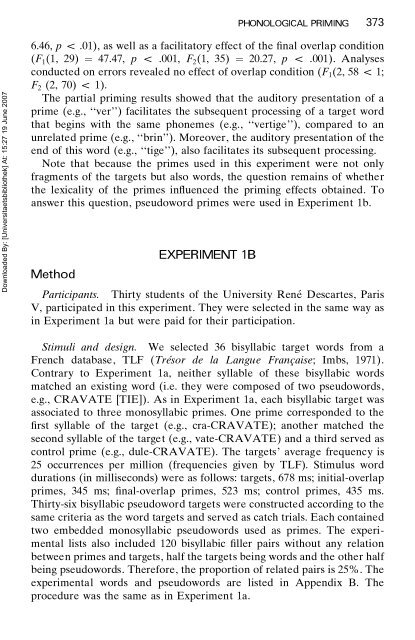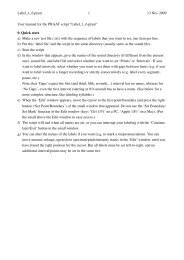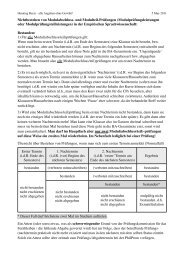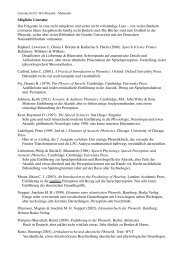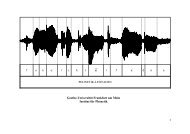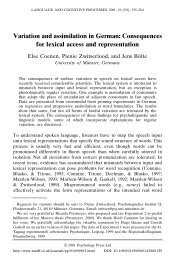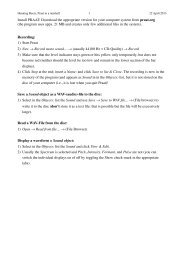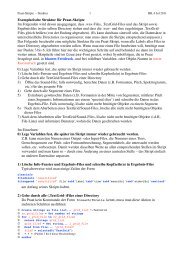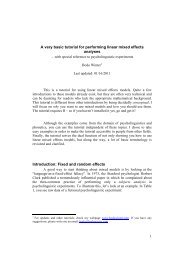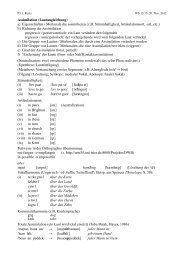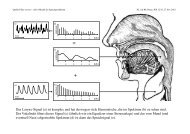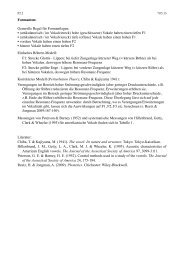Language and Cognitive Processes - Institut für Phonetik
Language and Cognitive Processes - Institut für Phonetik
Language and Cognitive Processes - Institut für Phonetik
Create successful ePaper yourself
Turn your PDF publications into a flip-book with our unique Google optimized e-Paper software.
Downloaded By: [Universitaetsbibliothek] At: 15:27 19 June 2007<br />
PHONOLOGICAL PRIMING 373<br />
6.46, p < .01), as well as a facilitatory effect of the nal overlap condition<br />
(F 1(1, 29) ˆ 47.47, p < .001, F 2(1, 35) ˆ 20.27, p < .001). Analyses<br />
conducted on errors revealed no effect of overlap condition (F 1(2, 58 < 1;<br />
F 2 (2, 70) < 1).<br />
The partial priming results showed that the auditory presentation of a<br />
prime (e.g., ‘‘ver’’) facilitates the subsequent processing of a target word<br />
that begins with the same phonemes (e.g., ‘‘vertige’’), compared to an<br />
unrelated prime (e.g., ‘‘brin’’). Moreover, the auditory presentation of the<br />
end of this word (e.g., ‘‘tige’’), also facilitates its subsequent processing.<br />
Note that because the primes used in this experiment were not only<br />
fragments of the targets but also words, the question remains of whether<br />
the lexicality of the primes inuenced the priming effects obtained. To<br />
answer this question, pseudoword primes were used in Experiment 1b.<br />
Method<br />
EXPERIMENT 1B<br />
Participants. Thirty students of the University René Descartes, Paris<br />
V, participated in this experiment. They were selected in the same way as<br />
in Experiment 1a but were paid for their participation.<br />
Stimuli <strong>and</strong> design. We selected 36 bisyllabic target words from a<br />
French database, TLF (Trésor de la Langue Française; Imbs, 1971).<br />
Contrary to Experiment 1a, neither syllable of these bisyllabic words<br />
matched an existing word (i.e. they were composed of two pseudowords,<br />
e.g., CRAVATE [TIE]). As in Experiment 1a, each bisyllabic target was<br />
associated to three monosyllabic primes. One prime corresponded to the<br />
rst syllable of the target (e.g., cra-CRAVATE); another matched the<br />
second syllable of the target (e.g., vate-CRAVATE) <strong>and</strong> a third served as<br />
control prime (e.g., dule-CRAVATE). The targets’ average frequency is<br />
25 occurrences per million (frequencies given by TLF). Stimulus word<br />
durations (in milliseconds) were as follows: targets, 678 ms; initial-overlap<br />
primes, 345 ms; nal-overlap primes, 523 ms; control primes, 435 ms.<br />
Thirty-six bisyllabic pseudoword targets were constructed according to the<br />
same criteria as the word targets <strong>and</strong> served as catch trials. Each contained<br />
two embedded monosyllabic pseudowords used as primes. The experimental<br />
lists also included 120 bisyllabic ller pairs without any relation<br />
between primes <strong>and</strong> targets, half the targets being words <strong>and</strong> the other half<br />
being pseudowords. Therefore, the proportion of related pairs is 25%. The<br />
experimental words <strong>and</strong> pseudowords are listed in Appendix B. The<br />
procedure was the same as in Experiment 1a.


